Discover 15 hidden attractions, cool sights, and unusual things to do in Norwalk (United States). Don't miss out on these must-see attractions: Maritime Aquarium at Norwalk, Cranbury Park, and Calf Pasture Beach. Also, be sure to include Stepping Stones Museum for Children in your itinerary.
Below, you can find the list of the most amazing places you should visit in Norwalk (Connecticut).
Table of Contents
Maritime Aquarium at Norwalk
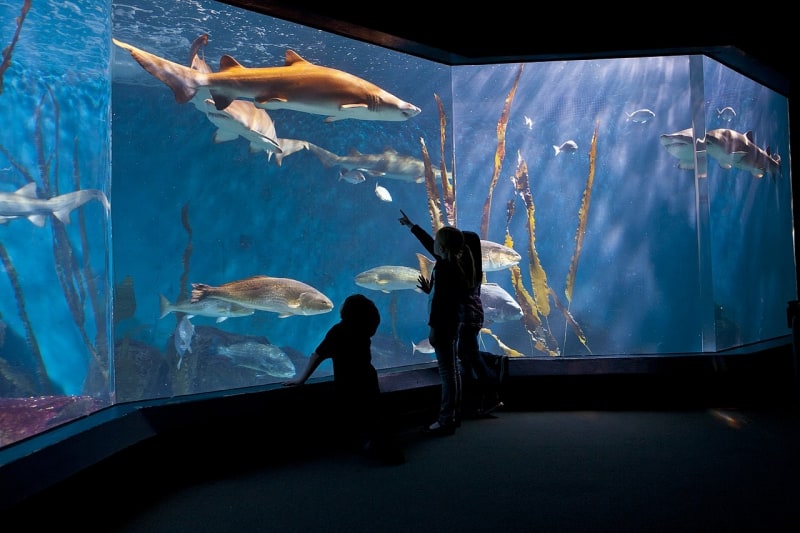
The Maritime Aquarium at Norwalk is an aquarium located in the South Norwalk section of Norwalk, Connecticut.
The aquarium features harbor seals, river otters, sharks, jellyfish, loggerhead turtles, and hundreds of other animals living in re-creations of their natural Long Island Sound habitats. Three touch tanks feature stingrays, nurse sharks, crabs, sea stars, moon jellies and other coastal creatures.
In addition to its exhibits, The Maritime Aquarium offers educational programs, year-round cruises on its 64-foot research vessel R/V Spirit of the Sound, special events and camps.[1]
Address: 10 N Water St, 06854 Norwalk (South Norwalk)
Cranbury Park
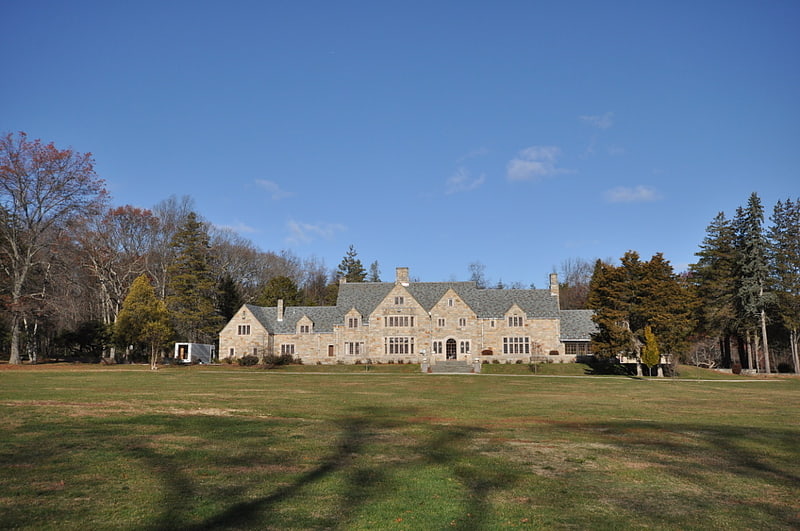
Cranbury Park is the largest public park in Norwalk, Connecticut. It is located in northern Norwalk, on the former Gallaher Estate, a 227-acre country estate developed in the 1920s by Edward Beach Gallaher, an important figure in the early American automobile industry. The park's amenities include miles of walking trails, a picnic pavilion, a disc golf course, and the Carriage House Arts Center, located in the estate's former carriage house. The park was listed on the National Register of Historic Places in 2011.[2]
Address: 300 Grumman Ave, Norwalk
Calf Pasture Beach
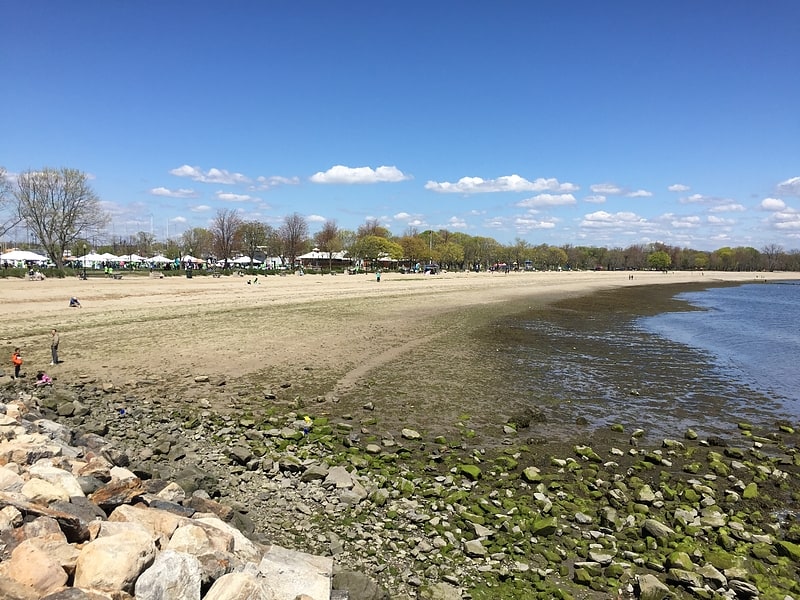
Beach in Norwalk, Connecticut. Calf Pasture Beach is a historically significant park and beach in Norwalk, Connecticut.
The area of the park lands (including adjacent Shady Beach Park and Taylor Farm Park) is approximately.45 square miles.
The beach is accessible by road or by public transit; Norwalk Transit District provides direct bus service to the park and the East Norwalk Metro-North station is about one mile to the north along Calf Pasture Beach Road, Gregory Boulevard, and East Avenue. East Avenue also provides access to I-95 at exit 16.[3]
Address: Calf Pasture Beach Rd, 06855 Norwalk
Stepping Stones Museum for Children

Museum in Norwalk, Connecticut. Stepping Stones Museum for Children is a hands-on children's museum for ages 10 and under located at 303 West Avenue, in the Central section of Norwalk, Connecticut.
The museum's interactive exhibit areas include: "Energy Lab"; a "Multimedia Gallery" with a theater, a state-of-the-art broadcast studio, and an 35-foot (11 m)-by-12-foot (3.7 m)-foot high-definition screen; Exhibits include "Healthyville", about bodies and healthy living; "Tot Town", an exploration area just for toddlers; "Family and Teacher Resource Center" where parents, caregivers and teachers have access to the latest and best information and programs about learning through play, early literacy, 21st century learning skills and the developmental needs of young children, helping them to facilitate a child's learning – at home or at school.
The entrance lobby houses ColorCoaster, a 27-foot (8.2 m) kinetic sculpture designed by artist George Rhoads.
The garden features three Kinetic Energy Sculptures designed by Beinfield Architecture, which use local solar, wind and water energy to delight and instruct museum-goers. This colorful set of kinetic sculptures demonstrate simple principles of energy generation while creating percussive music.
In 2011 the museum received LEED Gold Certification]. Recognized by the Governor of Connecticut as one of the first projects in the state to achieve LEED Gold status, the design employs a range of solutions, from energy efficiency and use of alternative energy sources, to ensuring healthy indoor air quality to water conservation. The building achieves a unique harmony between the site, the structure and the exhibits. Each element was harnessed to enhance the educational mission of the museum.
The museum is located in Mathews Park, adjacent to the Lockwood–Mathews Mansion, the Center for Contemporary Printmaking, a gallery and studio for printmaking, and Devon's Place, a playground designed for all children to play together, including those with physical, sensory and mental challenges.[4]
Address: 303 West Ave, 06850 Norwalk
Lockwood-Mathews Mansion Museum

Museum in Norwalk, Connecticut. The Lockwood–Mathews Mansion is a Second Empire style country house in Norwalk, Connecticut. Now a museum, it was built in 1864-68 for railroad and banking magnate LeGrand Lockwood. The 62-room 44,000 square feet mansion was listed on the National Register of Historic Places and was declared a National Historic Landmark in 1978.
It has been described as "one of the earliest and finest surviving Second Empire style country houses ever built in the United States." It sits at 295 West Ave. in Mathews Park, where the Stepping Stones Museum for Children is also located.[5]
Address: 299 West Ave, 06850-4002 Norwalk
East Norwalk Historical Cemetery

Cemetery in Norwalk, Connecticut. Established in c. 1655, the East Norwalk Historical Cemetery is Norwalk's oldest cemetery, and many of the area's first settlers are buried there. The cemetery is owned and maintained by the Third Taxing District, formally known as the East Norwalk Fire District of the Town of Norwalk, and before that it was known as the Down Town School District. Triangle shaped and surrounded clockwise by Gregory Boulevard, Cemetery Street and East Avenue it is situated in the neighborhood of East Norwalk.
At the north entrance of the grounds stands the First Settlers of Norwalk Memorial, inscribed with the following names of 31 settlers who founded Norwalk in 1649:
George Abbitt, Robert Beacham, Stephen Beckwith, John Bowton, Matthew Campfield, Nathaniel Eli, Thomas Fitch, John Griggorie, Samuel Hales, Thomas Hales, Walter Haite, Nathaniel Haies, Rev. Thomas Hanford, Richard Homes, Ralph Keiler, Daniel Kellogge, Thomas Lupton, Matthew Marvin, Sr. Matthew Marvin, Jr. Isacke More, Jonathan Marsh, Widow Morgan, Richard Olmsted, Nathaniel Richards, John Ruskoe, Matthias Sention, Sr. Matthias Sention, Jr. Matthew Sention, Thomas Seamer, Richard Webb, and Walter Keiler.
Many graves are unmarked by headstones as remains were deposited before stones were available, and of which no mark or tradition is known.
In 1843, the Down Town Cemetery Association was founded to maintain and conduct the business of the cemetery. In 1933, the name was changed to the East Norwalk Cemetery Association. In 1941, the Norwalk Third Taxing District entered into an agreement to supplement the association's perpetual care fund, due to a dwindling amount of donations. In 1966, the district took the deed to the land, so as to secure better insurance. Today, the district provides for the perpetual care of the grounds, while cemetery business is conducted by volunteers of the association.[6]
Sheffield Island Light
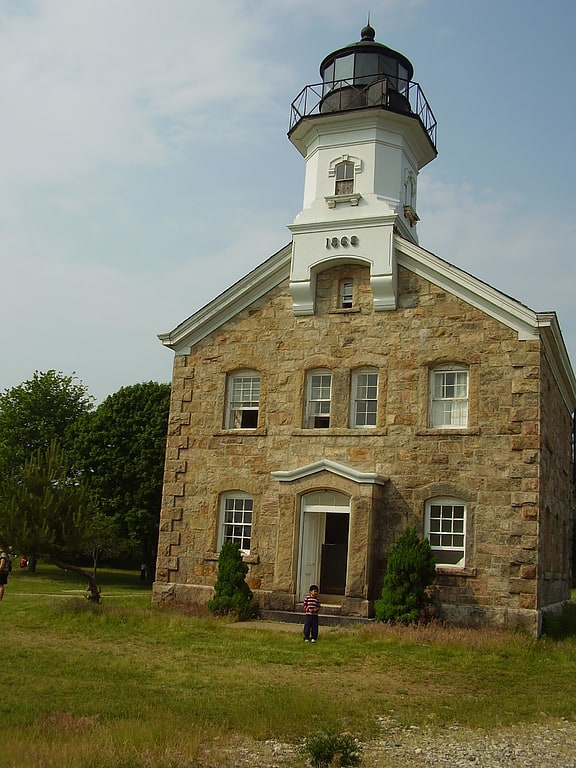
Sheffield Island Light is a historic lighthouse located at the southern end of the Norwalk Islands in Norwalk, Connecticut. It marks the west side of the mouth of the Norwalk River on northern Long Island Sound.
The island, at the time known as "White Island", was purchased by Captain Robert Sheffield in 1804 for $6000. In 1826 Gershom Smith, Sheffield's son in law, sold 4 of the island's 53 acres (21 ha) at the southwest point to the United States government for the purpose of building a lighthouse. Smith would serve as the first keeper for the light which was completed in 1828. At the time the island was known as Smith Island. The first light originally ran on oil.
In 1857 the light was upgraded to a fourth-order Fresnel lens. The original 30 feet (9.1 m) tower was replaced by a Victorian style limestone (masonry) dwelling, with a 44 feet (13 m) high light tower in the gable, in 1868. The Fresnel lens from 1857 was moved into the new structure and with a focal plane 51 feet (16 m) above water it was visible for more than 12 miles (19 km). The lighthouse is of the same design as lighthouses at Great Captain Island and Morgan Point in Connecticut; Old Field Point Light and Plum Island in New York; and Block Island North in Rhode Island.
Greens Ledge Light was built to the west of Sheffield in 1900 and was better located to warn ships of the rocks and shoals on the approach to Sheffield Island harbor and Norwalk harbor. Sheffield Island Light was then deactivated in 1902. Sheffield Island Lighthouse was put up for sale in 1914 and purchased by Thorsten O. Stabell. In 1986 the 118-year-old structure was purchased by the Norwalk Seaport Association for renovation and restoration. In 1989 the lighthouse was placed on the National Register of Historic Places. In 1993 an electric generator was added to the structure. In the fall of that year, a great storm flooded the basement of the building and artifacts were lost or destroyed. In 2002 the Seaport association started ferry service to the island, which is still running. In October 2011 the lighthouse was re-lit by a solar powered system installed to replace the gasoline generator system. The beacon is focused only on the Norwalk side and is not intended for use as navigation.[7]
Address: North Water & Washington Streets, Norwalk
Saint Mary Church

Catholic church in Norwalk, Connecticut. St. Mary is a Roman Catholic church in Norwalk, Connecticut, part of the Diocese of Bridgeport. As the first Catholic Church in Norwalk from which three other parishes developed, St. Mary's is considered the Mother Church of Norwalk.[8]
Norwalk River
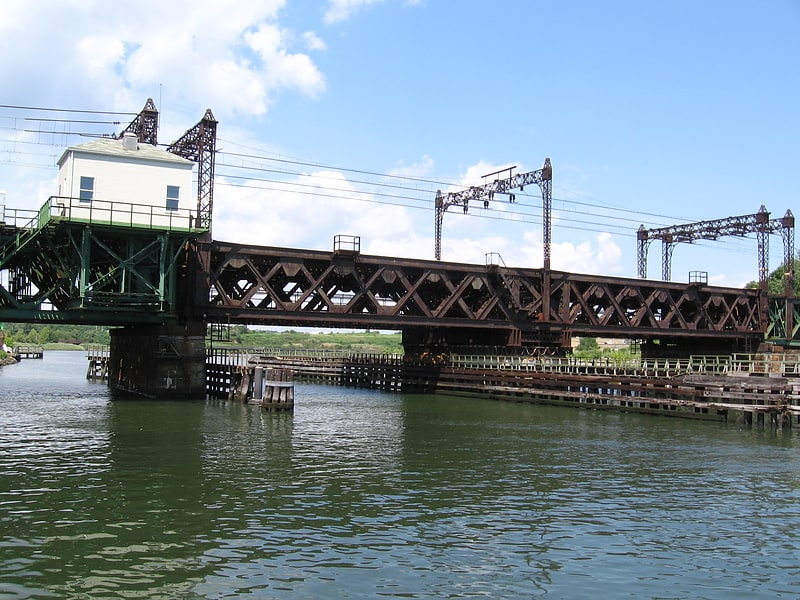
Swing bridge in Norwalk, Connecticut. The Norwalk River Railroad Bridge is a swing bridge built in 1896 for the New York, New Haven and Hartford Railroad. It currently carries Amtrak and Metro-North Railroad trains over the Norwalk River.
The current swing bridge is located at the same site where, in 1853, a train from New York City plummeted into the river while the previous swing bridge was open, resulting in dozens of deaths.
In 1896, the New Haven Railroad built the bridge and widened its route to four tracks, as it simultaneously built its South Norwalk Railroad Bridge over the intersection of Washington Street with North Main and South Main streets. The 562-foot (171 m) span, with a rotating swing span 202 feet (62 m) long was provided by the Berlin Iron Bridge Co. This type of swing bridge is one of just two on the Northeast Corridor. The swing span has a rim-bearing system of 96 rollers, allowing tall vessels to pass by. The span is one of only 13 of the company's bridges (and one of only two railroad bridges) that survive in the state as of August 2001. In 1907 the rail line was electrified with overhead catenary wires, which form a prominent feature of the bridge today. It is or was also known as Norwalk River Bridge. It was added to the National Register of Historic Places in 1987.
It is one of eight moveable bridges on the Amtrak route through Connecticut surveyed in one multiple property study in 1986. The eight bridges from west to east are: Mianus River Railroad Bridge at Cos Cob, built in 1904; the Norwalk River Railroad Bridge at Norwalk, 1896; Saugatuck River Railroad Bridge at Westport, 1905; Pequonnock River Railroad Bridge at Bridgeport, 1902; Housatonic River Railroad Bridge, at Devon, 1905; Connecticut River Railroad Bridge, Old Saybrook-Old Lyme, 1907; Niantic River Bridge, East Lyme-Waterford, 1907; and Thames River Bridge (Amtrak), Groton, built in 1919.
As a single movable span with aging mechanical mechanisms, the Norwalk River Bridge represents a frequent point of failure for Amtrak and Metro-North service and has been targeted for replacement with dual movable spans. The final design approved for the new Walk Bridge calls for a dual-span vertical-lift bridge.[9]
South Norwalk
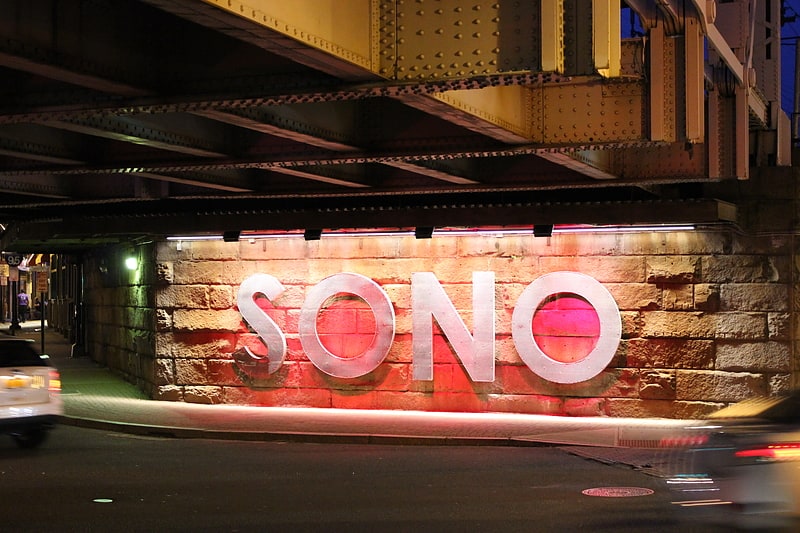
Neighborhood in Norwalk, Connecticut. South Norwalk is a neighborhood and the Second Taxing District in Norwalk, Connecticut. The neighborhood was originally a settlement called 'Old Well' which became chartered as the city of 'South Norwalk' on August 18, 1870. The cities of Norwalk and South Norwalk were incorporated on June 6, 1913. The neighborhood is often referred to with the acronym 'SoNo'.
South Norwalk is a diverse neighborhood both from a socioeconomic and racial perspective. Recent redevelopment is bringing new modern and affordable housing, a boutique hotel, and new businesses. The area provides one of the most attractive locales for industrial and other businesses within its confines. Families continue to move into South Norwalk for its competitive public school district and affordable real estate.
South Norwalk is host of the annual SoNo Arts Celebration, as well as the famed annual Oyster Festival. The SoNo Arts Fest is a free event that takes place every August and features over 100 fine art and craftsperson exhibits, as well as over 25 musical performances for all ages. The annual Oyster Festival, sponsored by the Norwalk Seaport Association, is an integral part of the culture of Norwalk, and has evolved into a community service event where over $200,000 is raised by various community groups to be distributed throughout the region in fulfillment of their mission to revitalize the harbor and preserve Norwalk's maritime heritage.[10]
Mill Hill Historic Park
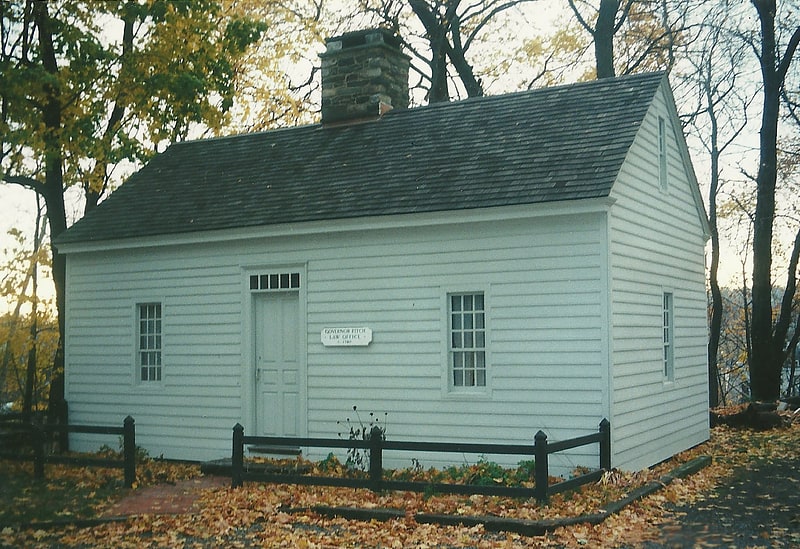
Museum in Norwalk, Connecticut. Mill Hill Historic Park in Norwalk, Connecticut is a living history museum composed of three buildings: the circa 1740 Governor Thomas Fitch IV "law office", the circa 1826 Downtown District Schoolhouse, and the 1835 Norwalk Town Hall; as well as a historic cemetery also called the Town House Hill Cemetery. The museum is also known as the Mill Hill Historical Complex in some references and the sign at the parking lot reads Norwalk Mill Hill Museum.
The Mill Hill Park is now maintained by the Norwalk Historical Society and the Norwalk-Village Green Chapter of the Daughters of the American Revolution.
Mill Hill Park can be found located along East Wall Street, bounded by Hubble Lane on its southeast and Smith Street to its southwest in Central Norwalk. “The burial ground on Mill Hill called Whitney's Hill in the records, after the miller, was opened for the use of members of the First Society (Congregational) in 1767.” The burying ground, which is now the third oldest in Norwalk, was established by the First Congregational church in 1767. There are 11 veterans of the American Revolutionary War buried in the Mill Hill Burying Ground.[11]
Address: 2 E Wall St, 06851-4815 Norwalk
St. Matthew Church
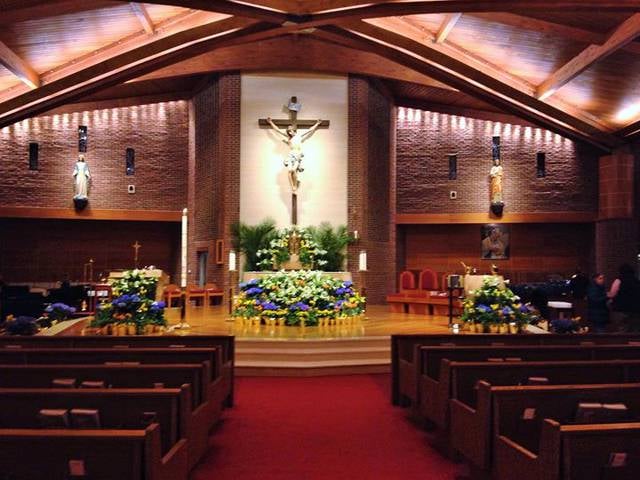
Catholic church in Norwalk, Connecticut. St. Matthew is a Roman Catholic church in Norwalk, Connecticut, part of the Diocese of Bridgeport.[12]
Address: 216 Scribner Ave, 06854 Norwalk
Norwalk Harbor
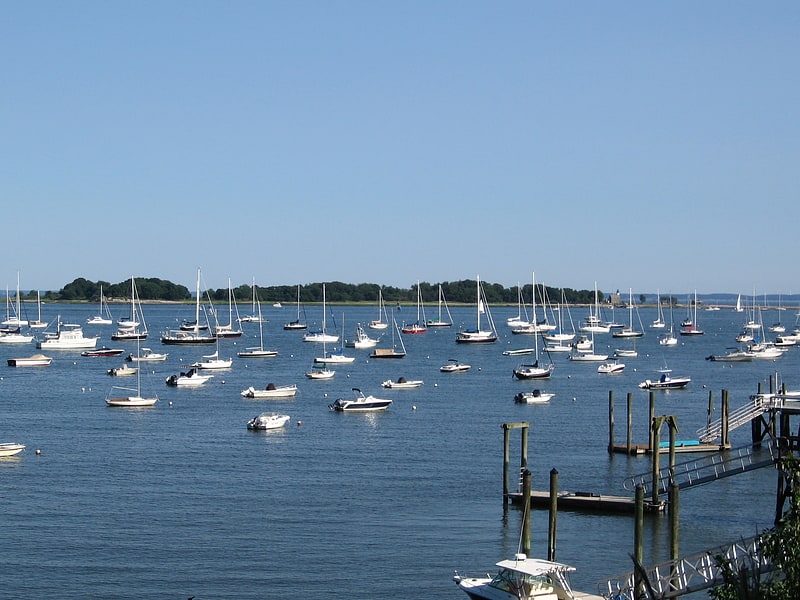
Norwalk Harbor is a recreational and commercial harbor and seaport at the estuary of the Norwalk River where it flows into Long Island Sound in Norwalk, Connecticut, United States.
The last portion of the Norwalk River from the head of navigation near Wall Street in Central Norwalk to the Long Island Sound forms Norwalk Harbor. It is a federal navigation channel of the "recreational and small commercial harbor" variety.
In and around the harbor there are 15 marinas, 13 private clubs with boating facilities, and 5 commercial port facilities. There are more than 1800 berthing spaces and more than 500 harbor mooring locations. About 800 boats may be launched from storage racks at marinas and clubs as well as via the city maintained launching ramp in Veterans Park. More than 2700 commercial vessel trips to and from the harbor occur each year. The main harbor channel is small enough to restrict the size of vessels that could attempt to use it. In 2001 waterborne commerce in the harbor totaled 512,000 short tons (464,000 t). Typical freight included fuel oil, sand, gravel, stone, and shellfish (particularly oysters and lobsters).[13]
Peck Ledge Light
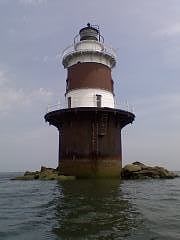
Lighthouse in Norwalk, Connecticut. Peck Ledge Light, also known as "Peck Ledge Lighthouse", is a sparkplug lighthouse in Norwalk, Connecticut, United States, southeast of Norwalk Harbor and northeast of Goose Island among the Norwalk Islands on Long Island Sound. The lighthouse is about two miles from Calf Pasture Beach in Norwalk and can be seen from the beach.
The cast-iron structure is still a working lighthouse operated by the United States Coast Guard and is not open to the public. The 54-foot-high (16 m) lighthouse is painted white with a brown band in the middle. Inside, the structure has three stories of living space along with a basement with cisterns for rainwater storage, all below a watchroom and lantern.[14]
Greens Ledge Light
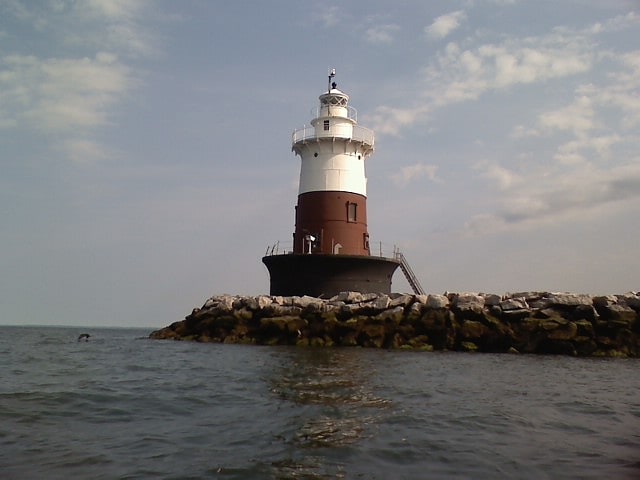
Lighthouse in Norwalk, Connecticut. Greens Ledge Light is a historic lighthouse in the western Long Island Sound near Norwalk, Connecticut and Darien, Connecticut. It is one of 33 sparkplug lighthouses still in existence in the United States and remains an active aid to navigation. It sits in ten feet of water on the west end of Greens Ledge, a shallow underwater reef that runs a mile west of Sheffield Island and is roughly a mile south of the entrance to Five Mile River at Rowayton. Completed in 1902 by the Philadelphia Construction Company, the cast-iron structure is approximately 90 feet tall including roughly 15 feet of the submerged caisson. In 1933, more than 30,000 tons of rocks from the excavation of Radio City Music Hall were added to the riprap foundation. The light was added to the National Register of Historic Places as Greens Ledge Lighthouse on May 29, 1990.
In 2017, Greens Ledge was acquired from the US Government by the Greens Ledge Light Preservation Society, a 501(c)3 nonprofit organization established by a group of local residents with the mission of restoring and preserving the lighthouse. The acquisition was made through a founding donation by The Pettee Family and restoration began in June 2018 to address the critical structural deficiencies of the lighthouse.[15]